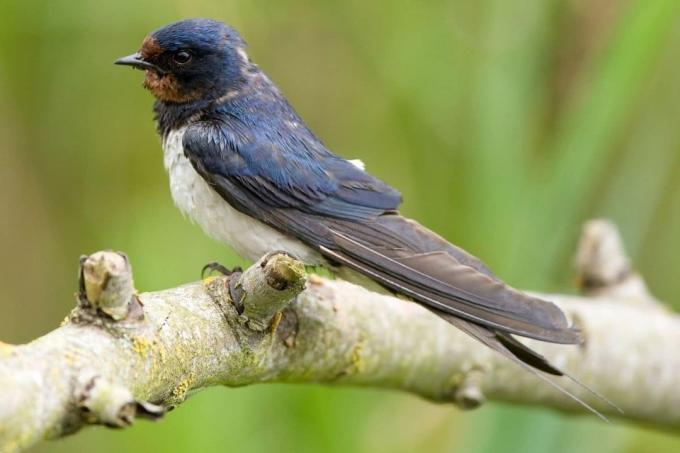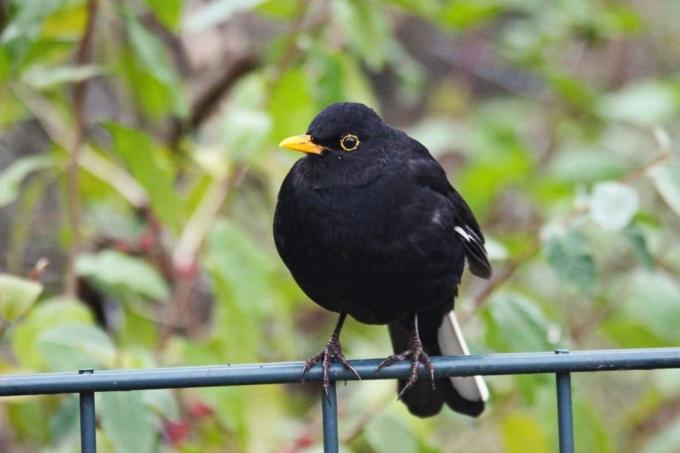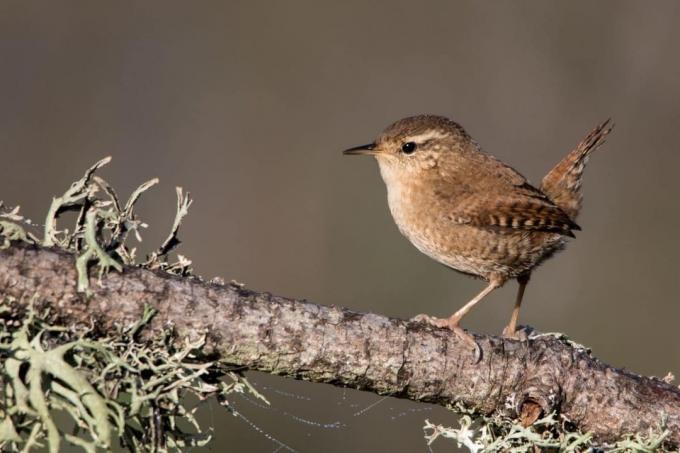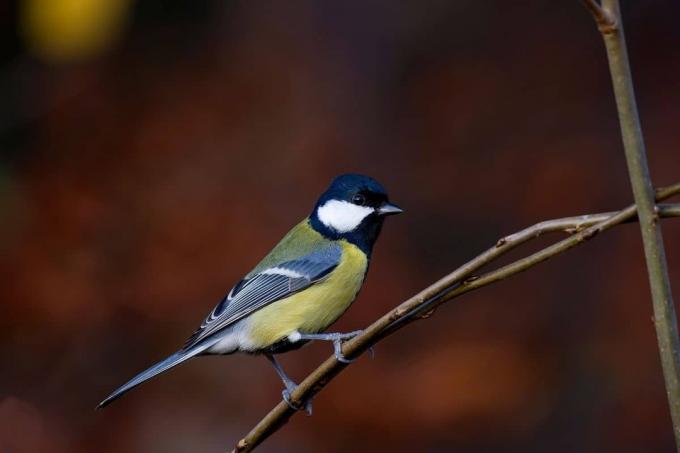
table of contents
- Early morning birdsong
- Bird watch: up to 60 minutes before sunrise
- Bird watch: up to 50 minutes before sunrise
- Bird watch: up to 45 minutes before sunrise
- Bird watch: up to 35 minutes before sunrise
- Bird watch: until 20 minutes before sunrise
- Bird watch: up to 10 minutes before sunrise
- frequently asked Questions
In the spring and summer months you can hear the birds chirping before sunrise. The different species cheerfully let their typical birdsong and follow very precise times. You can read here when which songbird sounds.
In a nutshell
- only songbirds sing
- mostly males to attract females willing to mate
- often early in the morning
- Sunrise as reference time
- each species of bird at a specific time and in a specific order
Early morning birdsong
During the Breeding seasonwhich occurs with most birds between March and July, the lively chirping of birds can be heard even before the first ray of sunshine. Sunrise and twilight serve the eager journeymen as reference times, which is why they do so during the summer months some songbirds can be heard as early as three in the morning - the earlier the sun rises, the earlier the animals become active. What disturbs so many human sleepers in their night's sleep, however, follows a sophisticated schedule. The different species do not sing as they please, but at very specific times. Basically, following the birdsong, you could set your watch accordingly - songbirds are so punctual to the minute.

Tip: If you want to distinguish the different species based on their singing, you can actually set the alarm clock and listen carefully. Our bird clock shows you when which songbird can be heard.
Bird watch: up to 60 minutes before sunrise
Common redstart (Phoenicurus phoenicurus)
The redstart begins its song at the earliest. The slim, strikingly colored bird is already starting to sing 80 minutes before sunrise and is between April and July to listen.
- Body length: 14 centimeters
- Wingspan: 21 to 25 centimeters
- Coloring of males: conspicuous, red chest and red tail with dark center, black throat, white forehead
- Coloring female: less conspicuous and lighter than the male, breast and belly tinged orange
- Singing: begins with a high and two low notes (“di-dada”), followed by chattering sounds
- Diet: insects, caterpillars, spiders, berries

Note: The breeding populations of the common redstart have declined sharply across Europe, mainly due to the loss of old wood stocks with many caves. You can help the species with a nest box hung in the garden.
Black redstart (Phoenicurus ochruros)
The more common black redstart begins approx. 70 minutes before sunrise to sing loudly. This type is between March and July to listen.
- Body length: 14 to 15 centimeters
- Wingspan: 23 to 27 centimeters
- Coloring of males: gray-black with white wing field, rust-red tail
- Coloring female: gray-brown, rust-red tail
- Singing: bright, rattling, crunching, whistling and hissing tones, very loud
- Food: insects, insect larvae, spiders, berries

Note: The black redstart was originally found only in stony mountainous areas, but is now common in human settlements. Instead of crevices in the rock, he uses various openings and niches in buildings to build nests.
Barn swallow (Hirundo rustica)
It is between April and July 60 minutes before sunrise to hear the barn swallow with their birdsong.
- Body length: 17 to 19 centimeters
- Wingspan: 32 to 34 centimeters
- Color: glossy blue-black with a white underside, forked tail, throat and forehead rust-red
- Singing: often calls "witt-witt" in flight; chirping singing ending with a thriller
- Occurrence: likes to breed in open buildings (e. B. Stables), therefore mainly to be found in villages
- Food: flying insects, especially mosquitoes and flies

Bird watch: up to 50 minutes before sunrise
Song thrush (Turdus philomelos)
The next in the early morning dance is the song thrush, which makes its beautiful birdsong 55 minutes before sunrise can be heard. You can choose between the pretty bird February and July listen.
- Body length: 23 centimeters
- Wingspan: 33 to 36 centimeters
- Color: upper side monochrome brown, light underside with darker spots, yellowish-brown lower wings
- Singing: sharp "zip", loud singing made up of short, repeatedly repeated stanzas
- Occurrence: in forests, parks and tree-lined gardens, preferably conifers
- Food: earthworms, snails, insects, berries, seeds

Note: The favorite food of the lively, cunning birds are shell snails, whose house is cracked open on a stone. Often such cracked snail shells can be found in certain places (so-called "throttle forges").
European robin (Erithacus rubecula)
50 minutes before sunrise the little robin lets out its sparkling song, often sitting slightly elevated on a branch. Its birdsong can usually be heard between February and July, but can also be heard in autumn and winter.
- Body length: 14 centimeters
- Wingspan: 20 to 22 centimeters
- Color: upper side and tail monochrome brown, chest and throat orange-red with a bluish border
- Singing: singing falling in pitch, sharp "tick" in rapid succession
- Food: insects, spiders, worms, snails, berries and other soft fruits

Note: In contrast to many other songbird species, not only the males sing in the robins, but also the females.
Bird watch: up to 45 minutes before sunrise
Blackbird (Turdus merula)
The blackbird, originally a forest bird, has become an indispensable part of cities and villages. The pretty, black species of thrush scolds loudly when there is danger (such as when a cat sneaks up) and brings off its melodic, fluting singing 45 minutes before sunrise until the summer evening hours. The morning birdsong is between February and July to listen.
- Body length: 24 to 25 centimeters
- Wingspan: 34 to 39 centimeters
- Coloring of males: black with yellow beak
- Coloring females: dark brown with a dark beak
- Singing: melodic and varied, fluting and trilling
- Food: earthworms, insects, snails, berries and fruits

Goldenhammer (Emberiza citrinella)
At the same time as the blackbird, the little goldhammer starts the day chirping. Between February and June the singing consisting of several short notes and a drawn out final note can be heard. With a little imagination, this can be rewritten as “I-I-I-love-you” and can also be heard on mild summer evenings.
- Body length: 16 to 17 centimeters
- Wingspan: 23 to 29 centimeters
- Coloring of males: upper side striped brown-black, chest band and rear back red-brown, golden-yellow head
- Coloring females: strongly striped underside, yellow stripes on the head
- Food: seeds and grains, also insects and spiders during brood

Blackcap (Sylvia atricapilla)
Together with blackbird and goldhammer, the melodic birdsong of the blackcap can be heard in the morning, the one between March and July sounds.
- Body length: 13 centimeters
- Wingspan: 20 to 23 centimeters
- Coloring of males: gray underside, black cap
- Coloring females: gray underside, red-brown cap
- Singing: starts chattering, then gets louder and louder and ends with a whistle; often hard, short "tak"
- Diet: insects, spiders, berries

Bird watch: up to 35 minutes before sunrise
Wren (Troglodytes troglodytes)
40 minutes before sunrise Finally the little wren lets out his loud, crashing birdsong. Despite its small size, the singing of the male wren is one of the most conspicuous and, at up to 90 decibels, one of the loudest in the domestic bird world.
- Body length: 9 to 10 centimeters
- Wingspan: 13 to 17 centimeters
- Color: brown with a dark brown upper side and light brown underside, short, typically raised tail
- Singing: widely audible, blaring singing with trilling and droning passages; calls hard "zrrrrt"
- Food: insects and spiders, in winter also seeds

Note: The wren is almost all year round to be heard, because he not only courted with his singing or demarcated the breeding territory, but also his feeding ground in winter.
Chiffchaff (Phylloscopus collybita)
away 35 minutes before sunrise the chiffchaff then begins its concert, which takes place in the Spring and summer can be heard almost everywhere. His name corresponds to his singing, which can be described as "zilp-zalp-zilp-zalp".
- Body length: 10 to 11 centimeters
- Wingspan: 15 to 21 centimeters
- Color: upper side greenish gray to olive brown, light underside, light stripes above the eyes, black legs
- Singing: unmistakably monotonous "zilp-zalp-zilp-zalp"
- Food: insects, insect larvae and pupae, spiders, woodlice as well as berries and seeds

Blue tit (Cyanistes caeruleus)
At the same time as the chiffchaff, the blue tit begins to sing. The pretty, unmistakably colored bird can be observed all year round.
- Body length: 12 centimeters
- Wingspan: 18 to 20 centimeters
- Coloring: yellow underside, wings, tail and cap blue, back green, white face
- Singing: long, high-pitched thriller; shouting calls ("zerrrrr")
- Food: insects, larvae, spiders and seeds

Note: In winter, the resident birds like to eat sunflower seeds, nuts, apples and berries. Blue tits can often be seen on bird feeders.
Bird watch: until 20 minutes before sunrise
Great tit (Parus major)
A little later than the blue tit, namely 30 minutes beforesunrise, sounds the twittering of birds of the similar great tit. Their variable singing is also often already from January to listen.
- Body length: 14 centimeters
- Wingspan: 23 to 25 centimeters
- Color: yellow underside, black stripe on the abdomen, black head with white cheek
- Singing: many different, sometimes loud, sometimes purring calls, often “zi-zi-bäh-zi-zi-bäh” food: insects, larvae, caterpillars, spiders in summer, seeds in winter

Fitis (Phylloscopus trochilus)
Outwardly very similar to the chiffchaff, Fitis is a real long-distance migrant who already lets out his powerful birdsong on the way to his Scandinavian homeland. The Fit singing is between April and June away 22 minutes before sunrise to listen.
- Body length: 11 centimeters
- Wingspan: 17 to 22 centimeters
- Color: greenish-gray upper side, light eye stripe, brownish legs
- Singing: melancholy singing falling in pitch with a flip at the end, often rising "hü-iht"
- Diet: insects and spiders, occasionally berries and other fruits

Goldfinch (Carduelis carduelis)
The eye-catching goldfinch sings 20 minutes before sunrise his songs. The pretty bird is from February to June to listen.
- Body length: 12 centimeters
- Wingspan: 21 to 25 centimeters
- Color: unmistakable red face mask, light brown back, wide yellow wing bands
- Singing: eponymous, three-syllable call ("sti-ge-litt"), chirping softly
- Diet: mainly seeds

Note: The species is also known as the "goldfinch" because the birds can often be seen on thistle flowers.
Bird watch: up to 10 minutes before sunrise
Greenfinch (Carduelis chloris)
The often canary-like song of the greenfinch can be heard 15 minutes before sunrise and is from January to July to listen.
- Body length: 15 centimeters
- Wingspan: 25 to 27 centimeters
- Coloring of males: yellowish-green underside, moss-green back, yellow wing feathers
- Coloring females: greyish green, less yellow wing feathers
- Singing: choppy singing made up of chirping and trilling elements with a long final note
- Diet: seeds, fruits and buds

Star (Sturnus vulgaris)
Likewise 15 minutes before sunrise the starlings begin their loud bird song, often imitating other bird calls. The birds are from January to September to listen.
- Body length: 22 centimeters
- Wingspan: 37 to 42 centimeters
- Color: shiny metallic black, yellow beak
- Singing: scratchy whistling and squeaking, hoarse "annoy"
- Diet: beetles, insects and insect larvae, cherries and berries

Chaffinch (Fringilla coelebs)
The male likes to sit on a free-standing branch to sing, then presents his pink breast and lets go 10 minutes before sunrise its loud, unmistakable singing can be heard. The paraphrase “I-I-I-am-your-groom” is helpful as a mnemonic.
- Body length: 14 centimeters
- Wingspan: 25 to 28 centimeters
- Color: underside brownish-pink, back darker, cap and neck blue-gray, two distinct white wing bands
- Singing: loud, crashing, sloping singing with a flap at the end
- Diet: beechnuts, berries and seeds, insects, spiders

Note: With roughly 200 million breeding pairs, the chaffinch is by far the most common bird species in Europe.
frequently asked Questions
The only actually nocturnal songbird is the nightingale (Luscinia megarhynchos), which usually lets out its loud song around midnight. The inconspicuously brown colored, with a length of around 16 centimeters, quite small birds inhabit dense bushes, well camouflaged. Otherwise you can mainly hear owls at night, but they don't sing or chirp like songbirds. More birdsong can mainly be heard in the early morning hours, just before or just after sunrise.
First and foremost, the busy twittering of birds is used for courtship, which is why the birdsong can be heard especially during the mating and breeding season from early spring to summer. It is mainly the males who sing, who want to attract the attention of females willing to mate with their beautiful singing. In addition, the twittering is also used for communication in many species, for example when each other Sparrows "talk" to each other or warn each other of approaching predators want.
In the literal sense of the word, not all birds actually “sing”, only the species classified under the term songbirds. This is a subordination of the passerine birds (Passeriformes), of which there are around 5000 different species worldwide. Of the approx. Most of the 250 native species have declined sharply or even threatened. All other bird species do not sing or chirp, but still make sounds. However, these are not primarily used for courtship, but for communication with each other.



